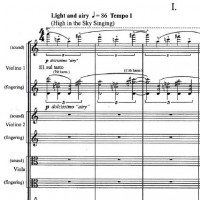Snapshots – Grace: Hans Abrahamsen
|
Dan Albertson [January 2013.] [I owe this article, and the series that I envision, to what I confess is an unlikely source, Mike Silverton, whose remit was for texts that may not easily fit elsewhere. Indeed, I am unsure how or if such texts will fit here! What I imagine is a sequence of short essays describing recent encounters with a single work by composers young and old. Often, a single piece serves uses far beyond its narrow parameters, being an opportunity to reexamine composers either adored or spurned and thereby either reinforcing or calling into question what one believes. This premise I aim to explore here.] Having decried the bulk of contemporary music, I take a rare opportunity to indulge in advocacy. Hans Abrahamsen, who turned 60 in December 2012, is an insular composer, not motivated by popularity or acclaim. He writes very little and fails to make grand statements about or through his music. His integrity and modesty, human and musical, is a sign of hope in an age overflowing with the fashionable, the gaudy and the pretentious. My best word for what Abrahamsen writes is glacial. I mean to suggest a stately post-music with an unusual sense of directness and a fondness for textural richness via minimal means. His passages often linger for far longer than any other composer could muster. Where lesser composers make the ephemeral seem infinite, Abrahamsen manages the opposite. Not least owing to the masterpiece Schnee for three trios (2006–08) and to my present preoccupation, a double issue of Contemporary Music Review on the string quartet in modernism and its offspring, I listened to his String Quartet No. 4 (2011–12). The performers were the Arditti String Quartet and I took in separate performances recently on BBC 3, from Huddersfield, and WDR 3, from Witten. Cast in two pairs of two movements, with 1 complementing 3 and 2 complementing 4, it is underwhelming on every level, in the best possible way. It seldom moves beyond the static, and is often only a whisper, but engages the emotion and the intellect alike as a reasoned result of its tamped enthusiasm. The general trajectory is one of harmonics yielding to pizzicati yielding to traditional arco. In denying the listener access to most of what is conventional in this medium in the 21st century, i. e., parades of techniques, wild changes in temperament, etc., Abrahamsen further ensures its success. Classifying it as a piece that is merely serene, however, would be a mistake. Indeed, in its fragility, the quartet shows a fortitude and a searing nature that belies its initial impression of tranquility. That Abrahamsen achieves such a variety from the simple juxtaposition of the stark and the schwach identifies him as someone with nil to prove, no desire to assert his originality and no need to dazzle – in brief, the ideal composer. He is a nonpareil. [Schnee can be found on Winter and Winter 910 159-2. The first two string quartets live on Dacapo DCCD 9006 with two quartets by Poul Ruders. G.C.C.]
[More Dan Albertson, Snapshots]
[More
Abrahamsen]
[Previous Article:
Looking for Pettersson, Stumbling across Locatelli]
[Next Article:
Four, </br>Four Tom, </br>Four Tom John, </br>Four Tom Johnsons]
|
